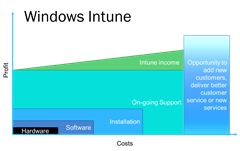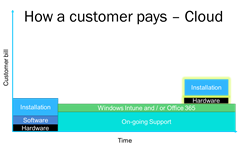Hi,
I don’t run my own business offering support to customers, but I thought I would put out a suggestion, since some partners have asked me “how do I make money from the cloud?”
Before I start I really do have to stress that this is NOT MY DAY JOB and that my opinions here are MINE and not those of Microsoft. They may align, they may not, but I have been thinking about this and wanted to share MY thoughts and then see what others had to say about it.
There are so many answers and depending on the customer, the answer may well be “you can’t, not yet.” However, I’ve tried to draw 3 comparison graphs on how I see things changing. I mean, the number of times I’ve heard SBSC partners say “I want the management functionality of SBS, but I don’t want Exchange”, well, we have that with SBS Essentials now. There are other times when customers don’t visit the office often enough and while Direct Access can solve some problems, only if the customer has the infrastructure for it. If not, unless a PC visits the office or VPN’s in, then the policies do not get applied.
So, we know what Windows Intune “does” versus the SBS servers as I’ve described this here. The next question for a partner is what is the impact on my revenue and profit margin. I’ve tried to depict this with some very simple graphics of this below. I’m thinking of a customer who wants desktop management or desktop plus Exchange and SharePoint. It would be great to know if this is too simple or the concept is wrong – please feel free to comment below.
SBS costs and profit
 You can see from the picture that hardware, while expensive have a very small (if any) profit associated to it. The same is true of software, especially if it is Microsoft software which I’m told has lower margins that some other people’s.
You can see from the picture that hardware, while expensive have a very small (if any) profit associated to it. The same is true of software, especially if it is Microsoft software which I’m told has lower margins that some other people’s.
We then come onto the services elements. The first part is installation. For some people this is a lower revenue and profit part of the process. This is then followed up by the support element which is often a higher margin part of the business, especially over time.
Nothing wrong with this model, we all have to earn a living and it works well for typical on premises solutions.
Windows Intune costs and profit

When we look at the picture from a Windows Intune solution, the picture only changes a little. The hardware and software elements shrink a little, but especially if new desktops are required, only a little.
When we look at the services elements again the really interesting thing here is that this discussion takes me back to my early SBS days when I was talking to partners about Windows+Exchange (or some hosted horrible pop thing) versus SBS. Partners were worried that by decreasing some of the time taken to setup and configure, they would devalue themselves because they did not major on post-install services. I think this discussion from 8 years ago is long dead now, but it does appear to have some common elements. With Windows Intune (and Office 365 if appropriate), some of the cost of installing, configuring and providing support are lowered. This could well mean that the revenue for these services decreases too as the time taken is less.
 However, there is now revenue coming in from the Windows Intune subscriptions that has no additional cost associated to it, so is pure profit, that adds to the revenue and profit lines. Also, the remote management features without the on-premise technology to look after should reduce the cost of supplying that solution. This should enable you to put your resources to better use. By resources I mean people. They should now have free time to offer other value added services to further increase revenue or time to grow new and existing customers without taking on further cost.
However, there is now revenue coming in from the Windows Intune subscriptions that has no additional cost associated to it, so is pure profit, that adds to the revenue and profit lines. Also, the remote management features without the on-premise technology to look after should reduce the cost of supplying that solution. This should enable you to put your resources to better use. By resources I mean people. They should now have free time to offer other value added services to further increase revenue or time to grow new and existing customers without taking on further cost.
Another area that has often been a difficult discussion with customers is around upgrades, however the services get upgraded automatically for you, whether this is just Windows Intune (which includes Windows on the desktop) or Office 365 which can include Exchange and SharePoint as well as Office on the desktop depending on the edition you sign up to. All of a sudden you can deliver upgraded tools for no software charges and upgraded desktops for additional fees should you desire.
If we now look at how a customer has to pay for these services over time we see a picture like this for traditional services delivered on premise:

When we look at the Windows Intune and Office 365 option we see a much flatter billing for the customer:

There are two particular thoughts to pick up here. The first is that the initial cost and potentially the on-going costs are more acceptable to the customer. Making the initial investment lower will help customers sign up to a solution, removing one of the barriers to new customer acquisition. The other point relates to upgrades. They become easier and cheaper to deliver with the customer not having such a high cost to stomach to move forward, even if they are entitled to. For some upgrades there will be no hardware costs and the installation fees may be included in the service charge anyway.
Anyway, this is how I see the business model panning out for those customers who want to move towards less technology on premise, or those partners who want to offer their customers alternatives to a SBS on premise solution.
It would be great to hear your comments as it will certainly inform me as to what is really happening out there in the market and what partners really think. I will happily share back with the right people in Microsoft if I have it wrong as I’ve been telling them this is what I think when they have asked me.
Thanks
David
Posted
Mon, Oct 31 2011 11:28 PM
by
David Overton